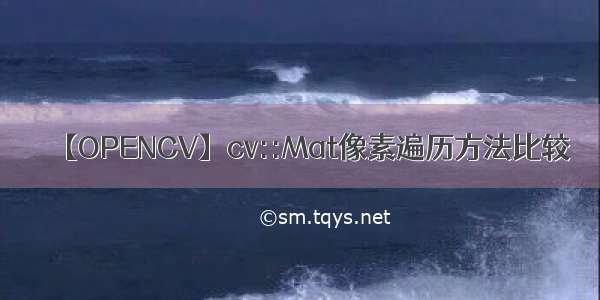
像素级别遍历是我们在图像任务中经常遇到的问题,在实时的图像处理中,能够高效的访问像素数据是很重要的。OpenCV中的数据容器是cv::Mat,cv::Mat提供了三种数据访问的方式分别是下标寻址,指针访问,迭代器访问。下面我们对比下这几种不同方式的访问速度。
#include <iostream>#include <assert.h>#include "opencv2/core/core.hpp"using namespace std;void method1(cv::Mat);void method2(cv::Mat);void method3(cv::Mat);void method4(cv::Mat);void method5(cv::Mat);void method6(cv::Mat);void method7(cv::Mat);int main(int argc, char* argv[]){ cv::Size imgSize(6400,4800); cv::Mat image = cv::Mat(imgSize, CV_8UC3, cv::Scalar(1,1,1)); method1(image); method2(image); method3(image); method4(image); method5(image); method6(image); method7(image);}void method1(cv::Mat img){ // at access with Vec3b Vector double t0 = (double) cv::getTickCount(); int height = img.rows; int width = img.cols; int sum = 0; for(int row=0; row < height; row++){ for(int col=0; col < width; col++){ cv::Vec3b uc_pixel = img.at<cv::Vec3b>(row, col); int a = uc_pixel[0]; int b = uc_pixel[1]; int c = uc_pixel[2]; sum += a + b + c; } } assert(sum==3*height*width); double time = ((double) cv::getTickCount() - t0) / cv::getTickFrequency(); std::cout << "Time for method1: " << time << std::endl;}void method2(cv::Mat img){ // direct at access double t0 = (double) cv::getTickCount(); int height = img.rows; int width = img.cols; int sum = 0; for(int row=0; row < height; row++){ for(int col=0; col < width; col++){ int a = img.at<cv::Vec3b>(row, col)[0]; int b = img.at<cv::Vec3b>(row, col)[1]; int c = img.at<cv::Vec3b>(row, col)[2]; sum += a + b + c; } } assert(sum==3*height*width); double time = ((double) cv::getTickCount() - t0) / cv::getTickFrequency(); std::cout << "Time for method2: " << time << std::endl;}void method3(cv::Mat img){ // pointer + Vec3b vector double t0 = (double) cv::getTickCount(); int height = img.rows; int width = img.cols; int sum = 0; for(int row=0; row < height; row++){ cv::Vec3b *ptr = img.ptr<cv::Vec3b>(row); for(int col=0; col < width; col++){ cv::Vec3b pixel = ptr[col]; int a = pixel[0]; int b = pixel[1]; int c = pixel[2]; sum += a + b + c; } } assert(sum==3*height*width); double time = ((double) cv::getTickCount() - t0) / cv::getTickFrequency(); std::cout << "Time for method3: " << time << std::endl;}void method4(cv::Mat img){ // pointer double t0 = (double) cv::getTickCount(); int height = img.rows; int width = img.cols; int sum = 0; for(int row=0; row < height; row++){ cv::Vec3b *ptr = img.ptr<cv::Vec3b>(row); for(int col=0; col < width; col++){ int a = ptr[col][0]; int b = ptr[col][1]; int c = ptr[col][2]; sum += a + b + c; } } assert(sum==3*height*width); double time = ((double) cv::getTickCount() - t0) / cv::getTickFrequency(); std::cout << "Time for method4: " << time << std::endl;}void method5(cv::Mat img){ // raw pointer double t0 = (double) cv::getTickCount(); int height = img.rows; int width = img.cols; int sum=0; for(int row=0; row < height; row++){ const uchar *ptr = img.ptr(row); for(int col=0; col < width; col++){ const uchar *uc_pixel = ptr; int a = uc_pixel[0]; int b = uc_pixel[1]; int c = uc_pixel[2]; // int a = ptr[0]; // int b = ptr[1]; // int c = ptr[2]; sum += a + b + c; ptr += 3; } } assert(sum==3*height*width); double time = ((double) cv::getTickCount() - t0) / cv::getTickFrequency(); std::cout << "Time for method5: " << time << std::endl;}void method6(cv::Mat img){ // raw pointer + raw step double t0 = (double) cv::getTickCount(); int height = img.rows; int width = img.cols; int sum = 0; const uchar *uc_pixel = img.data; for(int row=0; row < height; row++){ uc_pixel = img.data + row*img.step; for(int col=0; col < width; col++){ int a = uc_pixel[0]; int b = uc_pixel[1]; int c = uc_pixel[2]; sum += a + b + c; uc_pixel += 3; } } assert(sum==3*height*width); double time = ((double) cv::getTickCount() - t0) / cv::getTickFrequency(); std::cout << "Time for method6: " << time << std::endl;}void method7(cv::Mat image){ double t0 = (double) cv::getTickCount(); int height = image.rows; int width = image.cols; cv::MatConstIterator_<cv::Vec3b> it = image.begin<cv::Vec3b>(), it_end = image.end<cv::Vec3b>(); int sum = 0; for(; it != it_end; ++it){ int a = (*it)[0]; int b = (*it)[1]; int c = (*it)[2]; sum += a + b + c; } assert(sum==3*height*width); double time = ((double) cv::getTickCount() - t0) / cv::getTickFrequency(); std::cout << "Time for method7: " << time << std::endl;}
Time for method1: 0.586296Time for method2: 0.414636Time for method3: 0.504703Time for method4: 0.207575Time for method5: 0.111554Time for method6: 0.0940078Time for method7: 0.522204
对比这几种方式我们可以发现,最为高效的还是直接使用指针计算地址偏移量, 然而这种方式必须保证Mat在内存的存储是连续的,可以通过cv::Mat::isContinous()函数检测,如果是连续的则可以处理为单行向量,使用最为高效的方式访问。如果不想这么麻烦,其实method5是一种较为可取的方式,通过从cv::Mat::ptr()得到每一行的首地址,这样就不需要保证连续存储,速度和纯粹使用指针也差不了多少。
实际上对于method5,不使用中间指针进行改写的话:
void method5(cv::Mat img){ // raw pointer double t0 = (double) cv::getTickCount(); int height = img.rows; int width = img.cols; int sum=0; for(int row=0; row < height; row++){ const uchar *ptr = img.ptr(row); for(int col=0; col < width; col++){ // const uchar *uc_pixel = ptr; // int a = uc_pixel[0]; // int b = uc_pixel[1]; // int c = uc_pixel[2]; // 不使用中间指针 int a = ptr[0]; int b = ptr[1]; int c = ptr[2]; sum += a + b + c; ptr += 3; } } assert(sum==3*height*width); double time = ((double) cv::getTickCount() - t0) / cv::getTickFrequency(); std::cout << "Time for method5: " << time << std::endl;}
重新测试下:
Time for method1: 0.58601Time for method2: 0.416404Time for method3: 0.507943Time for method4: 0.208068Time for method5: 0.0918915Time for method6: 0.0917811Time for method7: 0.523099
时间上已经十分接近method6,实际操作的时候直接使用method5,不使用中间指针即可。
Reference
//07/which-way-of-accessing-pixels-in-opencv-is-the-fastest/
/xiaowei_cqu/article/details/19839019
/ajianyingxiaoqinghan/article/details/72391523
如果觉得《【OPENCV】cv::Mat像素遍历方法比较》对你有帮助,请点赞、收藏,并留下你的观点哦!













